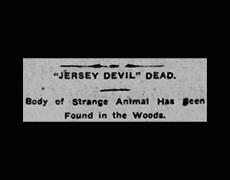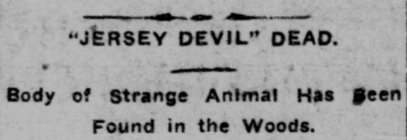
In the following report, the carcass of an unknown animal is discovered. Being unable to identify the remains, some declare that it is the Jersey Devil.
“Jersey Devil” Dead

KINKORA, N.J., October 31, 1909 — If anybody ever doubted that a “Jersey devil” left its strange and puzzling hoof prints in the snow of this and adjoining states last winter, proof was produced here today that the scare was never due to highballs.
There is on exhibit in this city the carcass of the queerest animal ever seen about here, a beast not on the schedule of any natural history ever read by any one of this section.
The animal’s body, still in good condition, as though it had been dead only a short while, was found by Morris Cabinsky, of this city, and Charles Malsbury, of Kinkora, in the woods near Kinkora on Tuesday, and was brought to this city, where hundreds have seen and marveled.
Photographs have been made of the beast, and Prof. Henry Morse, curator of the State Museum, will be asked to give the animal a name, and place it where it belongs, if he is able to do so.
The boys thought at first they had come upon the carcass of a big wildcat, but it looked so queer to them that they decided to carry it into town.
The body of the animal is about 20 inches long, and thin. The spinal column extends 6 inches behind the junction with the hind legs, like the tall kangaroo, but this again is tipped with 9 inches of tail like a squirrel’s, but of reddish-brown fur.
The strangest feature of all and that which would seem to convict it of last winter’s famous hoof prints, is found in the forelegs and feet. The legs are 15 inches long, consisting of four joints and socketed to these are the feet which take the form of a broad, flat bone with a distinct heel.
The foot bones are 2-1/2 inches long, and over an inch broad in a solid piece.
If the animal traveled by leaps, bending the two forefeet down together he would land after each long spring with the feet forming the puzzling effect of hoof prints as seen in the snow last winter.
The rear feet would explain the finding of “cat” prints near the hoof marks.
What looks like the framework of a pair of short wings rises from the animal’s back, just above its short hind legs.
The big mouth is set with sharp teeth three-quarters of an inch long, while the head is adorned with long, lance-like ears and whiskers, 4 inches long.
Source: Daily press. (Newport News, Va.), 31 Oct. 1909.

